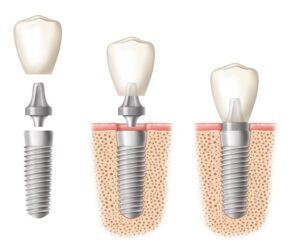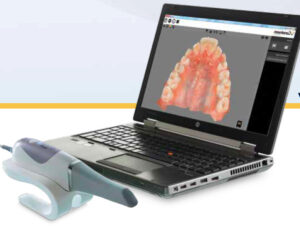Header logo
header top contact widget
Tooth Loss
Some Amazing History & ‘Back Stories” of Dental Implants!
Posted on Mar 11, 2022 by William J. Claiborne, DDS MS
Some “baby boomers” may recall a popular television show, The Six Million Dollar Man. The series ran from 1973 to 1978, with Lee Majors playing the role of Steve Austin, a former astronaut. After a NASA test flight accident, Steve had been rebuilt with bionic implants that gave him a number of superhuman qualities.
When this aired over 40 years ago, it seemed so futuristic; yet today, bionic implants are rather commonplace. One of the reasons is through the refined use of titanium.
Titanium was discovered in Great Britain in 1791 and named after the Titans of Greek mythology. Titanium is 60 percent denser than aluminum, but more than twice as strong. Titanium is non-magnetic, resistant to corrosion and has a strength-to-density ratio that is the highest of any metallic element.
Titanium can be alloyed (combined with additional element(s), such as iron, aluminum, vanadium, and other elements. These combinations can produce strong, lightweight alloys for a vast number of uses. Titanium is used for jet engines, missiles, spacecraft, and in the military, automotive, agriculture (farming) industries. Titanium is often used in medical prostheses, orthopedic implants, dental instruments used in root canals, and dental implants. Other uses range from components in sporting goods (such as golf clubs), jewelry and mobile phones.
Because titanium alloys have a high crack resistance, they are used in aircraft, armor plating, naval ships, spacecraft, and missiles. About two-thirds of all titanium metal produced is used in aircraft engines and frames. Titanium is also used in nuclear waste storage.
Because titanium is resistant to corrosion by sea water, it is used to make propeller shafts, rigging, and heat exchangers in desalination plants; along with many other uses for salt water components. Titanium is used in the housings and components of ocean-deployed surveillance and monitoring devices for science and the military.
The human body has also been given the advantages of titanium as it is biocompatible (non-toxic and not rejected by the body). Titanium is often used in surgical instruments, such as those used in image-guided surgery, as well as wheelchairs, crutches, and any other products where high strength and low weight are desirable. Inside the body, titanium is common in surgical implements and implants, such as hip balls and sockets (joint replacement) and dental implants that can remain dependably positioned for decades.
For orthopedic implants, the use of titanium means that skeletal loads are more evenly shared between bone and implant. This lowers the potential for bone degradation due to stress, reducing the risk of bone fractures, which have a tendency to occur at the boundaries of orthopedic implants.
Patients with titanium implants can be safely examined with magnetic resonance imaging (MRI).
When you think of dental implants – or other implants-in-bone, such as knees, hip joints, etc. – titanium has the remarkable ability to osseointegrate. Osseointegration is a term used when an artificial implant is surgically anchored into bone, in which the bone then grows around the implant. This restores strength and stability to the bone that can offer a lifetime solution.
The bone in which an implant is placed also benefits from the presence of titanium. In the jaw bone, where natural tooth roots are missing, their absence leaves the bone mass without stimulation once provided by the tooth’s roots. This stimulation is what helps the bone to maintain its mass.
Once bone loss begins, the pace of bone shrinkage, known as resorption, accelerates over time. The declining bone mass soon begins to cause a number of problems, including a change in the way a denture or partial fits.
Additionally, losing jaw bone mass causes changes in facial appearance. It may first appear as deep wrinkling around the mouth and as the corners of the mouth begin to turn downward, even when smiling. Jowls form as facial muscles detach from the shrinking bone. Over time, the mouth begins to sink inward and the chin moves closer to the tip of the nose.
Placing a dental implant into the bone halts the process of resorption. It recreates the stimulation once provided by natural tooth roots. And, because of the strength and stability of the implanted portions, patients with dental implants can rely on eating the foods they love again, biting and chewing with confidence.
https://en.wikipedia.org/wiki/Titanium
Having teeth is important for a number of reasons (eating, speech, appearance), which has been recognized throughout history. The first evidence of dental implants is attributed to the Mayan population roughly around 600 AD where they excelled in utilizing pieces of shells as implants as a replacement for mandibular teeth. Radiographs of Mayan mandibles show compact bone formation around the implants. It has also been found that, around 800 AD, a stone implant was shaped and placed in the lower jaw in early Honduran culture.
In addition to being the first U.S. president, George Washington is famous for his “wooden” teeth. History reveals that Mr. Washington suffered from dental problems from his twenties on. As a matter of fact, in his First Inaugural Address speech in 1789, Washington had only a single remaining natural tooth. Over the years, he wore several sets of dentures, but none made of wood. These were fashioned out of materials that included ivory, gold, lead, and human teeth.
In a letter to Washington from dentist John Greenwood (who fabricated dentures for Washington), he pointed out the staining of the dentures, likely due to consumption of Port wine. Dr. Greenwood cited the staining was what gave the dentures a grained, wooden appearance.
https://www.mountvernon.org/library/digitalhistory/digital-encyclopedia/article/wooden-teeth-myth/
Today, most of the “teeth” portions (restorations) are made of porcelain. Porcelain provides the most natural look and feel of “real” teeth with a similar luminosity of that of natural teeth. Porcelain is also highly durable the most resistant to staining.
To clarify a “dental implant”, it is a term that sums up what is actually a combination of components. Dental implants are typically three segments – the implanted portion that is held in the jaw bone, a post (abutment) that is positioned inside the implant and extends above the gums, and the attached replacement teeth (restorations).
A periodontist has have three years of specialized training beyond dental school to make them experts on both soft and hard tissues. Thus, they have the ideal combination of experience and knowledge to make sure you get a dental implant solution that looks and feels like your own teeth.
Because many people have lost one or more teeth due to periodontal disease, periodontists are an ideal choice in helping restore the gums to a healthy state while determining the best type of dental implant, and then placing the implant at the proper angle and depth.
Additionally, a periodontist can perform pre-implant placement procedures, which may be needed in certain cases. These can include:
Sinus Augmentation – The upper back jaw has traditionally been one of the most difficult areas to successfully place dental implants due to insufficient bone quantity and quality and the close proximity to the sinus. Sinus augmentation can help correct this problem by raising the sinus floor and developing bone for the placement of dental implants.
Ridge Modification – Deformities in the upper or lower jaw can leave you with and inadequate amount of bone in which to place dental implants. To correct the problem, the gum is lifted away from the ridge to expose the void where bone is missing. The void is then filled with bone or bone substitute to build up the ridge. Ridge modification has been shown to greatly improve the jaw’s appearance and increase the chances of successful implants.
Once your dental implant(s) is in place, your periodontal specialist can create a plan to help you maintain healthy implants, particularly in the prevention of peri-implant disease.
Peri-implant diseases are inflammatory conditions affecting the soft and hard gum tissues around dental implants. Similar to a natural tooth, bacteria can build up on the base of the implant, below the gum line. Over time, the bacteria irritate the gum tissue, causing it to become inflamed, damaging the tissue and if not caught early, causing the bone structure below the implant to deteriorate.
The history of dental implants is interesting, yet, what people want is to have their smile back and to enjoy the function of “real” teeth. Although the back stories of dental implants are many, what is most important is that we restore your smile and help you enjoy it for your lifetime.
Begin with a consultation in our comfortable Asheville periodontal dental office. Here, we can discuss what may be best for your needs in a private setting. We can discuss comfort options (including sedation), and estimated costs and treatment time. Here, you will be respected and treated with the compassion we would want for ourselves and loved ones.
Call 828-274-9440 to begin. You’ll speak with a member of our staff who will be happy to assist you.
ED Risks Higher With Presence of Gum Disease
Posted on Feb 25, 2022 by William J. Claiborne, DDS MS
For over two decades, medical researchers have closely focused on inflammation in the body and its power to activate health problems, heart and cardiovascular diseases in particular.
It has been determined that inflammation anywhere in the body can set off a series of biochemical changes in the bloodstream; those that are designed to help the body repair inflamed tissues. However, when inflammation becomes chronic, blood chemistry never returns to normal, and trouble ensues. Researchers have noted this significantly in its increased risk of heart attack and stroke.

Think of chronic inflammation as a pan of water that is boiling on the stove. When the body is in proper control, the boiling process ceases when the stove is turned to “off.” In chronic inflammation, however, the water continues to boil even after the pan is removed from the stove top.
Chronic inflammation can exist in the mouth, set at a constant “boiling point” due to advanced gum disease (known as periodontitis). Common symptoms are puffy gums that turn red in color; inflamed, swollen, or bleeding gums; gums that loosen from the base of teeth; persistent bad breath; gums that become spongy and bleed easily; and, pus pockets that form on the gums at the base of teeth.
In addition to creating higher risks of heart disease and stroke, advanced gum disease has been shown to increase the risks for diabetes, arthritis, preterm babies, some cancers, Alzheimer’s disease, high blood pressure and erectile dysfunction (ED). Yes, even ED.
Below are findings of several recent studies showing that periodontitis to be a significant risk factor for erectile dysfunction. Rather telling is as gum disease worsens, so does erection impairment.
• Turkish investigators studied 162 men, age 30 to 40. Eighty-two of the participants had normal erection function and 80 who complained of ED. Some men in both groups had chronic periodontitis, but the condition was more than twice as prevalent in the ED group. Men with periodontitis who also presented with decayed or missing teeth showed the greatest level of ED.
• Chinese scientists examined data of several studies involving a total of 213,076 men. Compared with those who had good erection function, those with ED had three times the risk of periodontal disease.
• The University of Granada School of Dentistry found that men with severe gum disease are more than twice as likely to suffer from erectile dysfunction. This was true even after careful adjustments were made for other health issues that could distort the findings, including socioeconomic data. In the study, 80 men with clear indications of erectile dysfunction were given a periodontal examination. According to the researchers, 74 percent of the participants with ED also presented with chronic periodontitis. The researchers concluded that patients with chronic periodontitis were more likely to have erectile dysfunction independent of other confounders.
• Israeli researchers surveyed the erection function of 305 men, average age 40, and then examined their gums. Those with chronic periodontitis had the greatest risk of ED.
The connection is actually logical. Periodontal disease has emerged as an independent risk factor for cardiovascular disease, and cardiovascular disease raises risk for ED. These studies show that everything that raises the risk for cardiovascular disease (such as smoking, obesity, chronic stress, high cholesterol, high blood pressure, and chronic sleep apnea) also raises the risk of ED.
This finding also makes biochemical sense. During sexual arousal, the body releases nitric oxide, which plays a key role in enabling erection. Chronic inflammations, including periodontal disease, impairs release of nitric oxide and contributes to ED.
Health risks such as our propensity for cancer or a decline in eyesight can occur regardless of lifestyle choices. However, it makes perfect sense to eliminate or greatly minimize risk factors, including periodontal disease. Research findings on ED’s association with infectious oral bacteria of gum disease will hopefully spurn more men to devote a higher level of commitment to care for their gums.
It takes mere minutes a day to maintain a healthy mouth and reduce the risks for developing gum disease.
 These include brushing teeth for at least two minutes twice a day. Daily flossing will remove bacteria in the gums that may elude brushing. And, keeping the mouth moist will support saliva flow, the mouth’s natural rinsing agent.
These include brushing teeth for at least two minutes twice a day. Daily flossing will remove bacteria in the gums that may elude brushing. And, keeping the mouth moist will support saliva flow, the mouth’s natural rinsing agent.
If you feel your erections are worth the effort, then these measures will become higher priorities in your daily hygiene upkeep. It is also important to see a dentist regularly. If you don’t feel anything is wrong because “nothing hurts,” you are only cheating yourself.
Gum disease can exist without obvious symptoms. Catching it early and before it begins to “boil” will help you avoid costly and time-consuming treatment later. And, these steps may keep your sex life active.
If you are experiencing any of the signs of gum disease (as mentioned prior), please know that gum disease will only worsen without treatment. It is also the leading cause of adult tooth loss.
A periodontist is a dental specialist who treats all stages of gum disease. If it is found to exist, this periodontal specialist can help to resolve the problem and restore your smile to a healthy state in the most conservative way possible. He or she can then help you maintain good oral health, which will support your overall health.
For an examination, or to begin with a consultation, call 828-274-9440.
https://onlinelibrary.wiley.com/doi/abs/10.1111/jcpe.12909?af=R
Ages 65 & Over: Stay More Socially Involved With A Healthy Smile.
Posted on Feb 09, 2022 by William J. Claiborne, DDS MS
Science has shown that the act of smiling gives a boost to our mood. Even a “fake” smile triggers endorphins (feel-good chemicals) in the brain to release, providing a bit of a “natural high.”
There are many things that make us smile. Time spent with friends, family, and social activity are helpful in keeping an individual active and involved, and hopefully smiling. Unfortunately, older adults are more prone to social isolation. This has proven to be unhealthy, mentally, physically and yes, even for the health of a smile.
Older adults are already at a disadvantage when it comes to having a healthy, full smile. Some estimates show that over one-quarter (26 percent) of adults ages 65 and older have 8 or less remaining natural teeth. About 17 percent in this same age category are missing all of their teeth.
On a positive note, total tooth loss (being “fully edentulous”) in the 65 or older category is decreasing. When comparing the 5-year periods of 1999–2004 to 2011–2016, it dropped by nearly 30 percent.
However, tooth loss comes with many frustrations, and even embarrassment. Many adults who wear dentures or partial dentures to replace missing teeth have similar complaints: sore spots on tender gum tissues, difficulty biting or chewing, slips while speaking or laughing, discomfort and the fear of embarrassment.
These frustrations often lead to (1) a change in diet; and (2) less social involvement. When certain foods become too difficult to chew properly, adults often alter their diet, opting for softer foods that dissolve easily in the mouth. Unfortunately, these foods typically lack in protein and fiber needed for good health.
Too, improper chewing is challenging to the digestive system. It is no wonder that denture wearers have more gastrointestinal problems and take more medications than people who still have their natural teeth.
Social isolation and loneliness have been linked to numerous measures of health and well-being. One interesting study focused specifically on the effects of social isolation and loneliness in relationship to oral health.
The Chinese Longitudinal Healthy Longevity Survey was conducted in three time segments: 2011-12, 2014 and 2018. The purpose of the study was to asssess the effects of social isolation and loneliness on the rate of tooth loss.
Data of the survey was evaluated, with nearly 4300 adults 65 and older who were participants in at least two of the time segments. The findings showed that, as tooth loss increased, so did social isolation. This study provided strong evidence that social isolation was associated with fewer remaining teeth and even accelerated the pace of tooth loss.
This problem is not just one of our current 65+ age group. According to the U.S. Census, the number of American adults aged 65 years or older is expected to reach 98 million by 2060, making up nearly one-quarter of the overall population. This means that a 30-year-old today will be well within this age group in less than 40 years.
Currently, the poorest oral health in Americans 65 and over are those who are economically disadvantaged, have no insurance, smoke, and in racial and ethnic minorities. Additional factors are being disabled, homebound, or who live in nursing homes. After retirement, some adults lose insurance benefits and find that Medicare does not cover routine dental care.
A high percentage of older adults also have periodontal (gum) disease, the nation’s leading cause of adult tooth loss. Nearly 68 percent of adults aged 65 years or older have some level of gum disease. While nearly 1 in 5 older adults have lost all of their teeth, total tooth loss is twice as prevalent for adults ages 75 and older compared with the 65-74 age group.
Aging also increases the likelihood of developing oral cancer. Oral and pharyngeal cancers are primarily diagnosed in older adults at a median age of 62 years. Gum disease also increases risks of chronic diseases including arthritis, diabetes, heart disease, and stroke.
All of these challenges are why a periodontist can be instrumental in the health and well-being of adults, especially those in the “older” age groups.
A periodontist is a dental specialist who receives 4 years of undergraduate training at a college or university and goes on to earn a dental doctorate. After 4 years of dental school, they further their education for another 3-4 years before completing stringent requirements for a specialty certification in periodontics.
A periodontist begins by accurately diagnosing the stage of gum disease present, or if it does exist. Many people are surprised by its presence since it can exist without obvious signs or symptoms.
From there, we develop a customized treatment plan based upon factors such as the patient’s current overall health, their diet, medications, whether they smoke or drink alcohol, and their age. We also discuss sedation options if dental fear is a concern.
Treatment recommendations are made based on what will effectively resolve existing problems without over-treating or under-treating. By restoring the patient to good oral health, we are able to help many avoid tooth loss and rid their mouths (and thus, their bodies) from an overload of oral bacteria.
Periodontists also specialize in the diagnosis and placement of dental implants. They are trained to understand all the intricate concepts involved in selecting the proper type of implant. Additionally, they are skilled at placing implants at proper depths and angles. As they oversee your “healing” time, periodontists are able to optimize your comfort and outcome.
When tooth loss begins, replacing that tooth with a dental implant is highly advised. Dental implants are designed to last a lifetime and restore biting and chewing comfort and stability. Additionally, the stimulation they provide to the jaw bone helps to halt bone loss.
This is because the implanted portion, held by the jaw bone, recreates the presence of the natural tooth roots you once had. While a denture or partial is positioned on top of the gum tissues, dental implants have the advantage of the jaw bone as their foundation, just as natural teeth.
For those who feel they are “too old” for dental implants, many of our implant patients are well into their 80’s or 90’s. Keep in mind that today’s adults are staying in the workplace longer, staying active in senior years, and living longer. Since 1950, Americans added over 11 years to average life expectancy, to age 79, according to 2019 statistics.
At every age, your smile reflects you, and should be a positive reflection throughout your lifetime. If you are experiencing tooth loss, let’s discuss halting the process during a consultation appointment in our comfortable Asheville periodontal dental office.
Call 828-274-9440 to schedule an appointment.
https://www.cdc.gov/oralhealth/basics/adult-oral-health/adult_older.htm
Optimize Your Dental Implant Experience, Results.
Posted on Jan 24, 2022 by William J. Claiborne, DDS MS
I recently had to return a small appliance at a “big box” store. I didn’t have the receipt but hoped I could at least get a store credit. When I explained this to the customer service rep, she said a receipt wasn’t necessary. She scanned the bar code and asked me if I wanted the refunded amount applied to the credit card I used to purchase it. No receipt needed, no credit card, and I was in and out of the line in no time.
With today’s technology, many processes that were once time-consuming and complicated are now simple and “painless.” Less time is required with better results. Technology has made this true, too, in dentistry.
As a periodontist, I specialize in the prevention, diagnosis, and treatment of all stages of periodontal (gum) disease. I also have advanced training and skills in the selection and placement of dental implants. In addition, periodontists are particularly skilled in performing cosmetic periodontal procedures.
As an Asheville periodontal specialist for over 30 years, I’ve treated a variety of needs that involve the gum tissues. These include:
– Treatment of all stages of gum disease (gingivitis, pregnancy gingivitis, periodontal disease, periodontitis)
– Reshaping gum tissues for esthetic enhancement (crown lengthening, gingivectomy for ‘gummy smiles’, repairing areas of gum recession)
– Diagnosis and placement of dental implants
– Treatment of lesions or cysts in oral tissues
To receive the extensive, additional 3 years of training after dental school to become a periodontist, (I believe) an individual must be passionate about the specialty. I certainly am, which is why I’m so committed to stay on top of the latest developments in the field.
This includes incorporating some of the most advanced technology available for the betterment of our Western North Carolina patients.
Our periodontal dental office features cutting edge technology, much of which is not available in other dental or periodontal offices in this region. These features help to diagnose with precision, treatment plan with superior accuracy and reduces the patient’s treatment time while optimizing comfort.
For our dental implant patients, these options have been significantly beneficial in maximizing results. Some specifically helpful in dental implant diagnosis and planning are:
LANAP With PerioLase MVP 7 – Laser-Assisted New Attachment Procedure is an advanced protocol that efficiently and effectively treats advanced gum disease with the added advantages of a dental laser. For patients who are preparing for dental implant placement, resolving gum disease prior to treatment is mandatory. LANAP offers a non-surgical alternative for patients with moderate to severe periodontal disease with very little discomfort and a quick recovery time.
Cone Beam Imaging – These amazing 3D “x-rays’ are ideal for diagnosing and treatment planning. The highly-detailed images provide a clear view of the upper and lower jaw. Because cone beam radiographs show sagittal, axial, and coronal planes, locating and tracking nerve canals optimizes implant placement. The images are captured in a quick, painless process and at minimal levels of radiation.
CareStream Cone Beam Computer Tomography Imaging – This enhanced tomography works with 3D imaging for exceptional detail and range.
Computerized Dental Implant Placement – This system provides the futuristic ability to position dental implants before the process actually begins. Through computerized technology, the implants are selected and “ideally positioned” on a 3D model of the patient’s jaw. From this, a template is developed for optimal treatment success, even for complex cases.
CS 3600 Intraoral Scanner – Rather than make impressions with bulky, goopy trays, this scanner quickly and comfortably captures digital impressions accurately and easily. These are used to create precision models or appliances (dental implant crowns, bridges, or full arches). The scanner can also reach hard–to–access areas in the patient’s mouth for superior results with improved patient comfort.
Sedation – Our Asheville periodontal practice is known for its environment of comfort and respectful care. We understand that over 70 percent of the adult population have some level of dental fear or anxiety. For optimal comfort and relaxation, we offer several sedation options, including oral and IV sedation.
Oral sedation is a pill that helps patients relax. It also has an amnesiac effect, leaving most with little or no memory of treatment afterward.
I.V. sedation (also known as ‘twilight sleep’) places the patient in a deeper sleep state and erases memory of the procedure. It is administered by a Medical Doctor (MD) who is a board certified Anesthesiologist.
With both sedation options, patients are closely monitored with advanced safety equipment throughout treatment.
When it comes to placement of dental implants, a periodontist has a unique understanding of the tender layers of gum tissues. Using gentle and precise skills when it comes to any treatment involving oral tissues, the patient experiences less disruption and incisions. When it comes to the gums, less is definitely more. We strive to optimize comfort levels and speed the healing process.
If you are considering dental implants, you may wish to begin with a consultation appointment. During this time, we can explain the vast difference in comfort, treatment time, and success available through our specialized skills and extensive technology.
Call 828-274-9440 to schedule. New patients are always welcome and a referral is not required.
Recent Posts
Categories
Archives
- September 2024
- August 2024
- July 2024
- June 2024
- May 2024
- April 2024
- March 2024
- February 2024
- January 2024
- December 2023
- November 2023
- October 2023
- September 2023
- August 2023
- July 2023
- June 2023
- May 2023
- April 2023
- March 2023
- February 2023
- January 2023
- December 2022
- November 2022
- October 2022
- September 2022
- August 2022
- July 2022
- June 2022
- May 2022
- April 2022
- March 2022
- February 2022
- January 2022
- December 2021
- November 2021
- October 2021
- September 2021
- August 2021
- July 2021
- June 2021
- May 2021
- April 2021
- March 2021
- February 2021
- January 2021
- December 2020
- November 2020
- October 2020
- September 2020
- August 2020
- July 2020
- June 2020
- May 2020
- April 2020
- March 2020
- February 2020
- January 2020
- December 2019
- November 2019
- October 2019
- September 2019
- August 2019
- July 2019
- June 2019
- May 2019
- April 2019
- March 2019
- February 2019
- January 2019
- December 2018
- November 2018
- October 2018
- September 2018
- August 2018
- July 2018
- June 2018
- May 2018
- April 2018
- March 2018
- February 2018
- January 2018
- December 2017
- November 2017
- October 2017
- September 2017
- August 2017
- July 2017
- June 2017
- May 2017
- April 2017
- March 2017
- February 2017
- January 2017
- December 2016
- November 2016
- October 2016
- September 2016
- August 2016
- July 2016
- June 2016
- May 2016
- April 2016
- March 2016
- February 2016
- January 2016
- December 2015
- November 2015
- October 2015
- September 2015
- August 2015
- July 2015
- June 2015
- May 2015
- April 2015
- March 2015
- February 2015
- January 2015
- December 2014
- November 2014
- October 2014
- September 2014
- August 2014
- July 2014
- June 2014
- May 2014
- April 2014
- March 2014
- February 2014
- January 2014
- December 2013
- November 2013
- October 2013
- September 2013
- August 2013
- July 2013
- June 2013
- May 2013
- April 2013
- March 2013
- February 2013
- January 2013
- December 2012
- November 2012
- October 2012
- September 2012
- August 2012
- July 2012
- June 2012


